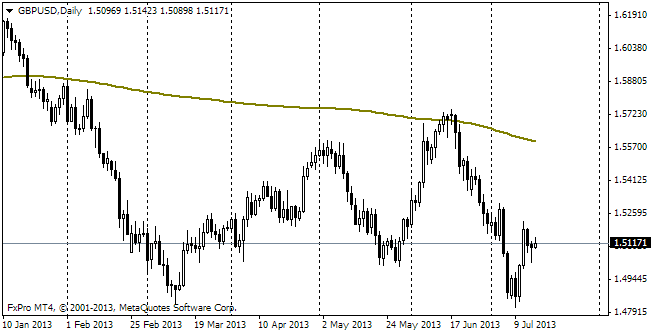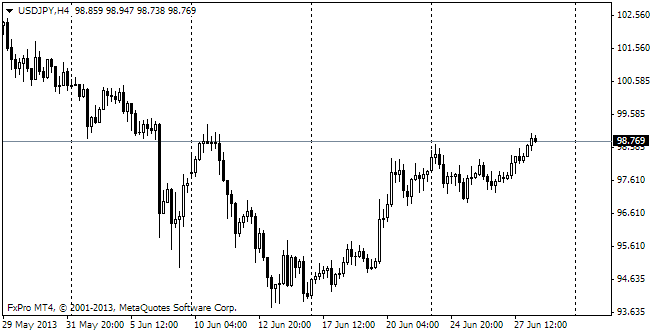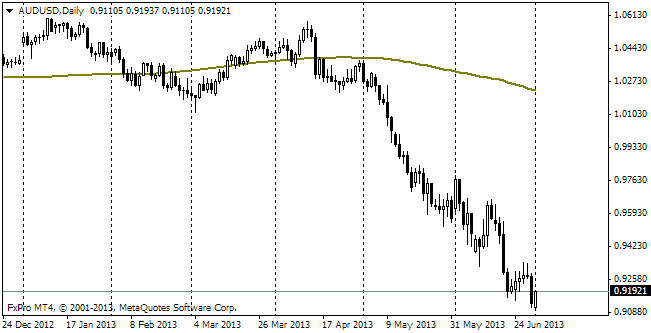EUR/USD
The euro/dollar has been depreciating for the recent two weeks. Despite the fact that during the last week the pair has mainly been close to 1.3700, we can't but notice that bears still contrive to push it lower and lower before bulls gain revenge. Yesterday's local low preceding the fomc meeting minutes brought the euro to 1.3634. The minutes themselves proved to be milder than could be expected. The news released before the meeting on April 29-30 was generally positive, so the market expected to see more confidence about tapering and, probably, more certainty about rates. However, ‘flexibility' in consideration of approaches to tapering of the ultra-soft monetary policy was treated as irresolution. The dollar proved to be under pressure and the stock exchanges recouped the losses of the previous day. Under the lead of yellen the Fed looks even milder than under Bernanke. The stock markets benefit from it, while the dollar remains relatively cheap because of that. Eventually this calmness may provoke a sharper rally towards USD, when the debt market yields resume their ascent. Now we see that they are again going down, thus contributing to decline of the rates, in the mortgage market as well. The Fed's softness only curbs weakening of eurusd, but it is not able to reverse the market, which is expecting decrease in the ECB's rates at the meeting in June. There's no resistance on the side of inflation: even in the fast-growing economy of Germany inflation forces are weak, to say nothing about the economizing periphery. The respected media sources report that even Germans are not against rate cuts. The experts once close to the ECB also say that there are no obstacles to rate cuts. Yet, we should understand that QE can't be expected here as it is targeted mainly at decreasing the bond yields and the latter are already at the historic lows even without this. Besides, the rate decrease by 0.12-0.25 of the percent is not a measure which can produce a drastic effect on the markets. A change in the investor sentiment is able to have much greater impact. The thing that seems to be real terra incognita is influence the negative deposit rate of the ECB might have on the market. In theory banks will have to activate lending not to pay the ECB for keeping excess reserves. We still have to see how effective it is in practice.
GBP/USD
Yesterday the pound again made itself conspicuous. The retail sales data and minutes of the BOE's meeting in May were released at the same time. The annual rate of sales growth proved to be the highest in the post-crisis period, making 6.9% due to the monthly rise by 1.3%. The growth rate excluding auto sales was more impressive – 1.8% m/m and 7.7% y/y. In their turn the minutes seem to reflect some discomfort with the current situation. Some members of the MPC are not sure that the volume of capacity utilization has been assessed correctly and that it will pose a serious obstacle to inflation. Yesterday the cable made two attempts to catch hold of 1.69. They were futile, but it should be noted that in the absence of news the pair is purchased more eagerly than sold.

USD/JPY
The ardour of the Japanese officials doesn't last for long. For a while we thought that the tradition would be broken by Abe and Kuroda. And if Abe still keeps his election pledges somehow, the bank of japan shows caution, which sharply contrasts the last year's activity. Yesterday's meeting of the BOJ didn't bring any changes into the policy as the Bank is sure about economic growth and weak influence of tax increases on the consumer activity. The factors are such that the initial impulse for prices as well as for the economy has exhausted itself. The dollar/yen has been growing for the last few hours only due to the outside demand for risk.

AUD/USD
The aussie keeps drifting between 0.92 and 0.94. Yesterday it pushed off the support of the mentioned range. There is a feeling that it will manage to get to its upper side in the coming week as the Australian statistics look more and more reassuring. Certain turmoil has been caused by the revision of the consumer inflation rate. The change of the formula has left us with the expected growth rate of 4.2% against 2.4% in April and resulted in 4.4% in May.
